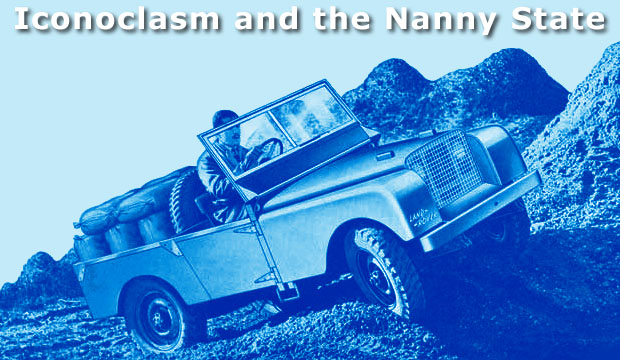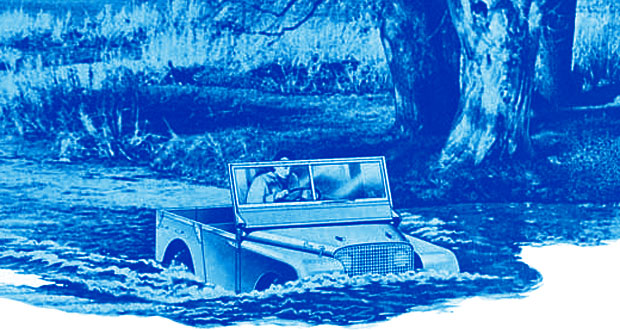|
|
 |
| My Favourite Planet > Blogs > Edwin Drood's Column > March 2015 |
 |
 |
back |
Edwin Drood's Column |
 |
10 March 2015 |
 |
|
 |
 |
In which Edwin laments the planned disappearance of a British legend
and wonders whether a universally recognizable brand item could justifiably
be considered for enrolment as a UNESCO World Heritage artefact.
 |
A few years ago I wrote about ‘sudden oak death’ in the UK and voiced the opinion that, far from being caused by some parasite or virus, it was probably due to the English having become such a nation of wet-socked, whining cry-babies that these noble trees, the very symbol of such erstwhile national virtues as fortitude, honesty, integrity and courage, are actually dying of shame. |
| Geneva conventions |
It is one of the conventions of the Geneva motor show, that car manufacturers use it as the springtime launch for significant changes to their most iconic models. This year we get a look at what will probably be the new platform and engine for Aston Martin. Meanwhile, Porsche stuns with not one, but two uncompromisingly track-focussed models, the 911 GT3 RS and the Cayman GT4, both of which have posted electrifying times on the Nordschleife and Land Rover introduce the next generation … wait a minute, no they don’t … the last generation of their brand-defining Defender.
 Did I really write that? Yes, I did, because it’s true. After almost seventy years of constant production, the Defender, which is a direct descendent of the series I and II vehicles built by Rover in the immediate post-war period, is finally being put definitively out to pasture, a vast field upon which, more than any other vehicle in the world, it has already made the deepest of marks. This, then, is the end of a noble line, the end of a glorious reign and the end of one of the last, true British icons. |
| The world’s off-roader |
For those who live on some other planet and don’t know what I’m waffling on about, the Land Rover Defender is not just any off-road, 4-wheel-drive vehicle: it is the world’s benchmark, the arbiter, simply “the best 4 by 4 by far”. Through seven decades, in either its 90 inch or 110 inch wheelbase variants, it has winched lifeboats out of the sea, travelled the entire length of South America off the highway grid, been to the North and South poles, served as a radio station, a school, a church, a locomotive, a dispensary, forded the world’s wildest rivers, wallowed and waded through cloying mudflows up to its windows, as well as delivered perishable vaccines and medical personnel to some of the most inhospitable regions of the earth.
 The intrepid little Land Rover has successfully wound down an empire and withdrawn an army of administrators with surprisingly little bloodshed. It has policed the savannahs of Kenya in search of poachers, carried camera crews for David Attenborough through the wildernesses of five continents, crossed more deserts than you’ve had hot dinners and – given the passion and loyalty it inspires in the armies of fifty nations – would probably have defeated Erwin Rommel’s Afrika Korps a whole lot quicker and shortened the war by several months if it had only been invented in time, as it is a swift, manoeuvrable and deadly foe when equipped with an anti-tank rocket launcher and an LMG. |
| Humble beginnings |
The Land Rover Series I & II emerged from a former “shadow factory” in Solihull. These were vast buildings erected to suggest aircraft production halls, as a decoy to enemy bombers. The Series I was initially registered as a “necessary agricultural vehicle” in the context of the post-war rationing of raw materials, and designed to serve as a stop-gap measure for Rover, keeping their much-reduced manufacturing capacity active after the destruction of their main facilities at Coventry. Thus everything about the Land Rover was intended to be idiot-proof. It could be constructed by largely unskilled labour on pretty primitive machines and could be maintained by eager amateurs with a couple of spanners and a hammer down on the farm. Its body panels were, and remain to this day, simple sheer-cut sheets of aluminium mounted on a ladder frame.
 Alongside this simplicity, the Land Rover’s other hallmark was its versatility. It could be equipped from the factory with mounting points for a variety of front and rear tow-hooks, winches, searchlights, emergency pontoons and other equipment. Its gauges were readable in poor conditions, it could be delivered with a vertical, flood-proof exhaust system, its windows and screen could be easily removed in the summer, its wipers could be worked by hand, if need be, and all its controls could be operated with gloves on! |
| Runaway success |
Not surprisingly – though for some reason it surprised the managers at Rover – the handy ‘Landy’ was a runaway success from the very first. It was everything a rural community in a deep crisis of labour and resources could want in a vehicle. In the depths of winter it could be guaranteed to get the wife to market and the kids to school, push a snowplough down the lane or run up a mountain pass in search of early lambs. The short-wheelbase version would carry a large farmer, his dog and three full-grown sheep in relative comfort and it came in a choice of colours: dark green … or stripped-aluminium-go-ahead-paint-it-yourself. Who could ask for more?
 Over the decades, the Land Rover Defender, as it has been called since 1983, has morphed from being the farmer’s friend, the horse-breeder’s tow truck, the explorers essential companion and the army’s go-to gun hauler to new roles as fashion statement, green-gumboot accessory and delivery system for the children of the West End elite to their private colleges deep in the trackless wastes of Kensington and Chelsea. Yet somehow, even though it has priced itself out of its original market, we have tended to forgive it such aberrations, simply for what it represents: the indomitable spirit and rugged straightforwardness of the breed we still like to think we are. |
| Custodian of a legend |
But we are not that breed. We haven’t been that breed since the 1970s. And so the Defender is going to its grave, carrying with it all the ‘core values’ and ‘brand DNA’ of which Land Rover, the custodian of this legend, claims to be so proud, yet seems so ready to sacrifice on the altar of modern industrial convenience. I get the impression that they are letting the Defender go down without a fight, which is a damn shame. They’re caving in to the Nanny State instead of summoning all the arguments that should be brought to bear when we’re talking about a vehicle as English as a Cheddar & Branston sandwich, as instantly nostalgic as a Beatrix Potter book and as immediately recognisable as the Beatles, Elgar or a jar of Marmite.

To be fair to the firm, which is now owned by Tata (who have done such a magnificent job with the resurrection of Jaguar … I refer my readers to my post on the messianic F-type: The Second Coming, Edwin Drood's Column, 1 April 2014), the Defender’s demise has been in the air for a long time. In a way, it’s a victim of its own success. Land Rover probably hates to see the Defender go, but while it is one thing to hold onto a small-edition vehicle for its cultural value, despite its safety and emissions issues, attempting to make that same ‘niche market’ argument for your top-selling model is a different matter altogether. |
| Regulated to death |
Emissions regulation has been a thorn in the flesh at Land Rover for decades. They make powerful workhorses that are almost all intended to function as effectively off-road as on. Such vehicles are by nature robust and over-engineered. This weight, in its turn, punishes your wallet and the atmosphere. However, and it’s a big however, 70% of all the Land Rovers ever built are still on the road today. Since the processes involved in vehicle production – especially for modern lightweights and hybrids, with all their gizmo technology dependent on rare elements and their weight savings dependent on chemical-intensive synthetic materials – still represent, by a wide margin, the most environmentally damaging phase in a car’s life, longevity such as this is not only a serious contribution to resource-sustainability but also a real-emissions benefactor when compared to the pollution engendered by the short, planned-obsolescence life cycle of the typical family car.
 As regards safety, the very last feature that a vehicle designed to go nose first down the side of a quarry needs is a “crumple zone”. But legislation is framed to provide security for passengers and other road users when a car impacts either with Joe Public, a motorway crash barrier or with another car. In all such cases a crumple zone seems like a very good idea. However, in your headlong dive down an Ethiopian gulley, you do not want your Defender to shy away and crumple like a wallflower at the first rock it encounters. You want it to take the dent in its stride, suck it up and move on. For the kind of ‘real men’ who are lifetime Land Rover drivers, the vehicle in front has traditionally been their crumple zone. This is not a very charitable attitude. And with the Defender now being driven more by Sloane Rangers than Lone Rangers, this is clearly becoming a problem. |
| Elegy for an icon |
Yet the safety argument, like the emissions argument, also crumples when you look at the numbers. The Defender is not fast (it’s zero to 60mph time is a staid 15 seconds), nor is it flashy in a curve. So it’s not the hot-hatch that zips round the corner and knee-caps your granny as she’s crossing the zebra. Neither is it the supercar driven by a toy-boy footballer, hurtling down the M5 into the back of your family saloon. The real number of Land Rover Defender road-traffic accidents is very, very small indeed. The typical Defender traffic accident either involves stray cattle or someone totalling their Renault Clio by reversing into you at Sainsbury’s. Otherwise, with a vehicle of this pedigree, your chances are far higher of being swept away by a flash-flood, buried alive in a sandstorm or having your brand new safari-trim Defender 110 trashed by elephants who find it makes a convenient back-rub.
 If the passing of the Defender is a sad affair, the British have brought it on themselves with their fetish for health and safety, their over-protective, helicopter-parenting attitude to the greater and lesser risks of life, their reliance on Nanny to fix everything. They whine when their investments go wonky, when their cricket team loses, when they gut their public broadcaster’s funding and then are surprised that it doesn’t deliver the content they expect, when they vote-in a coterie of mendocrats and suffer for eight years as a result, or when they sell off all the family silver and then wonder why nobody looks up to them anymore with their collapsed public services, hospitals, public transport and education system in jeopardy. Just as they don’t deserve the oak trees, they no longer deserve the emblematic qualities of the Land Rover Defender.
 But at least the Defender is going out in style … the company is issuing three special edition versions for its last year of production and has also made a truly brilliant piece of ephemeral art to symbolise the passing of an era. The video of this artwork, featuring six Defenders towing giant chain-hoes across Red Wharf Bay in Anglesey to execute a half-mile wide Land Rover Series I before the tide can wash it away, is shot on the same vast foreshore where Rover’s chief engineer Maurice Wilks once traced its distinctive shape in the sand during a family holiday over Easter, 1947, when Wilks was explaining his ideas for a Rover 4-wheel driven vehicle, much in the style of the versatile US Jeep, to his elder brother Spencer Wilks, the Chairman of Rover Cars. |
| Preserving our cultural heritage |
While the disgusting, throat-hacking Islamo-fascists in Iraq destroy what’s left of the millennial cultures of ancient Mesopotamia, just as their bearded brethren of the Taliban did in Afghanistan, let’s not criticize them over much. After all, we don’t take particularly good care of the easily preserved icons we still have, so why cry for those we have lost? Yet although it must be abundantly clear by now, that the UN cannot and will not lift so much as a finger to preserve that which its own cultural institution has catalogued as World Heritage, does that exempt us from nevertheless trying to save precious vessels of our culture before they die of neglect or are legislated out of existence?
 Among the various artefacts and sites that I’d like to see survive into the distant future from the extraordinarily rich century so recently past, two are perhaps not immediately obvious to the cultural eminences and their boards who deliberate upon what counts as World Heritage. The first is the Nordschleife circuit of the Nurburgring, the theatre of so much that was and still is great, daring and thrilling in the racing culture that has driven automotive development for over a hundred years, and the second? … the Land Rover Defender, of course, the only car in history to have been seen and heard by over half the population of the planet.
 To snatch this wonderful piece of kit, this serious tool from the interfering and all-shredding claws of Nanny should be an immediate priority. I’d have a preservation order slapped on it at once before it’s too late. And the only way to effectively preserve the cultural status and significance of a car is to go on building it, selling it and, above all, driving it, come hell or high water. In this case, preferably both!
© Edwin Drood, March 2015 |
|
| |

Illustrations from an early Land Rover press advertisement. |
| |

Carabinieri guard the streets of central Rome in their customized Land Rover Defender. |
| |

Land Rovers are particularly popular in Italy for official and private use.
Here, at Agrigento, one of many rugged Defenders spotted in Sicily. |
Edwin Drood's Column, the blog by The Mysterious Edwin Drood,

at My Favourite Planet Blogs.
We welcome all considerate responses to this article
and all other blogs on My Favourite Planet.
Please get in contact. |
 |
Visit the My Favourite Planet Group on Facebook.

Join the group, write a message or comment,
post photos and videos, start a discussion... |
|
Views of blog authors do not necessarily reflect those of the publishers
or anyone else at, on or in the vicinity of My Favourite Planet. |
 |
 |
|
|
| |
| |
|
| |
 |
| |
 |
| |
 |
| |

George Alvanos

rooms
in Kavala's historic Panagia District

Anthemiou 35,
Kavala, Greece

kavalarooms.gr
 |
| |

Olive Garden Restaurant

Kastellorizo, Greece

+30 22460 49 109

kastellorizo.de
 |
| |

Papoutsis
Travel Agency

Kastellorizo, Greece

+30 22460 49 286

greeklodgings.gr
 |
| |
|